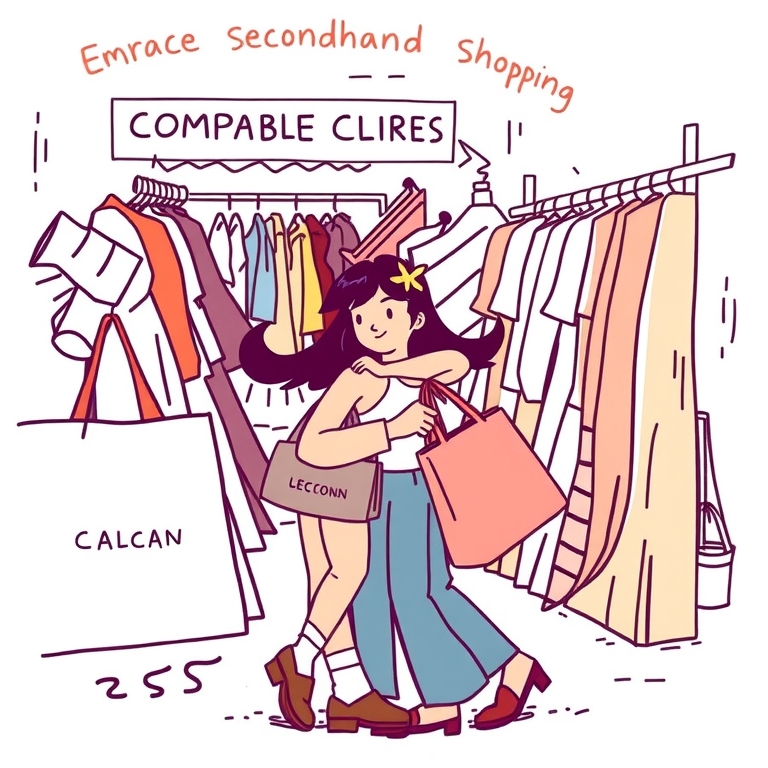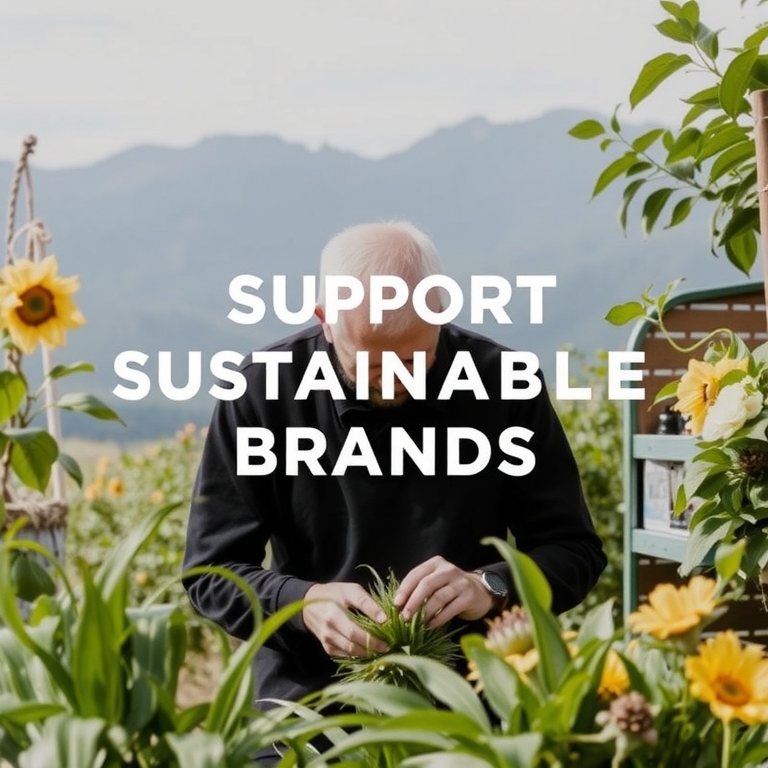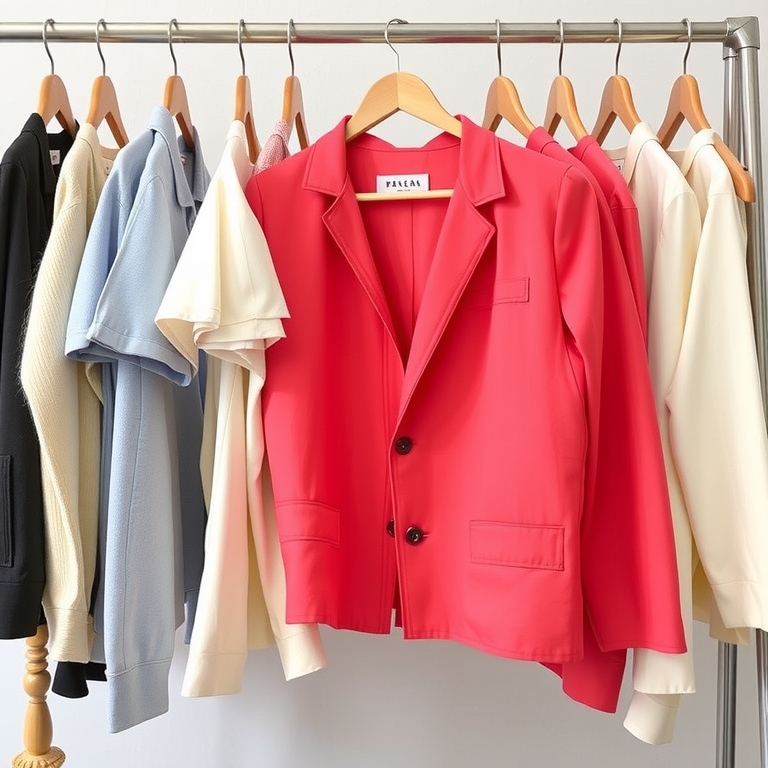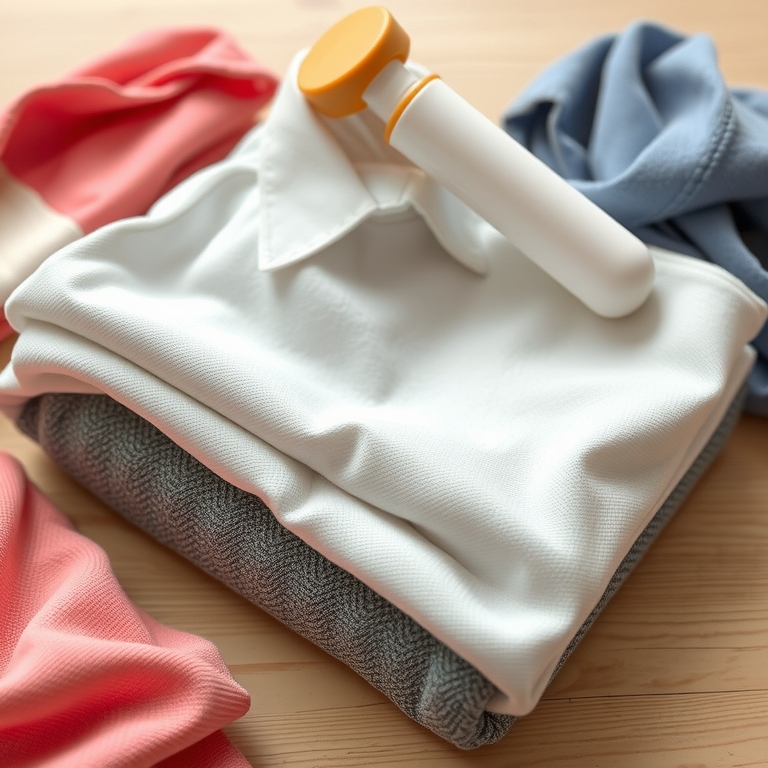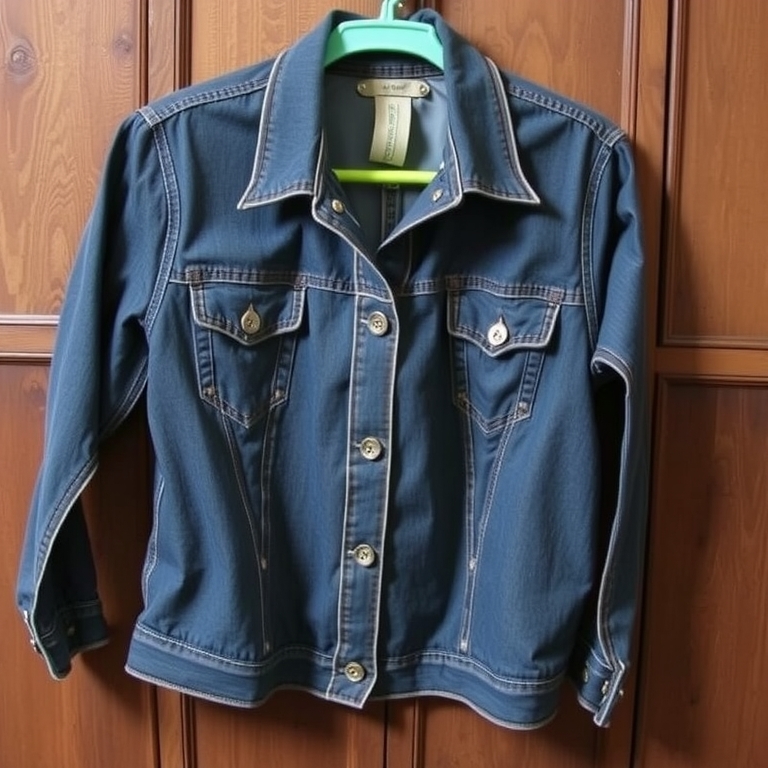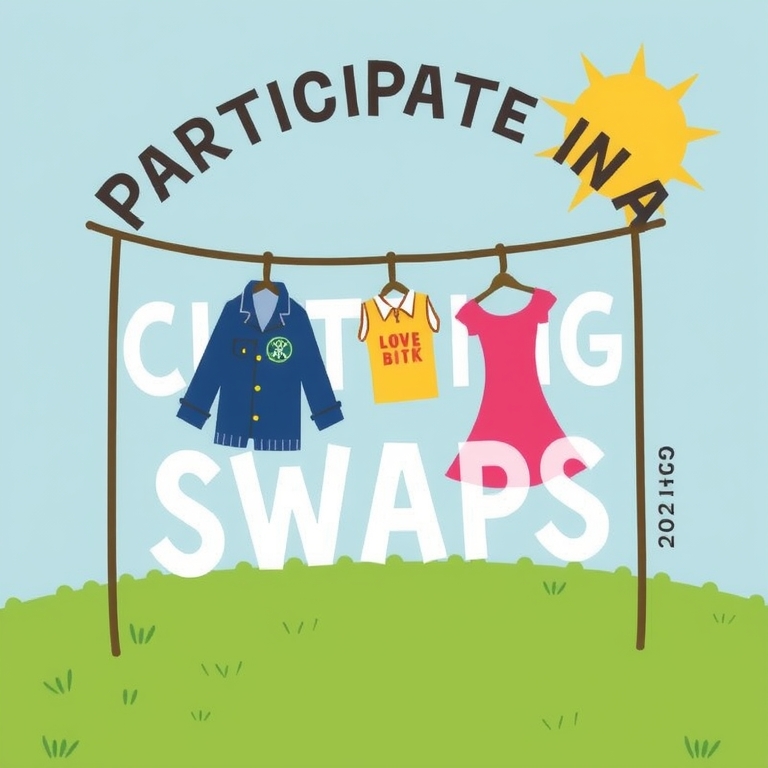Sustainable fashion is more than just a trend it’s a movement towards a more ethical and environmentally responsible way of dressing. It’s about making conscious choices that minimize your impact on the planet and support fair labor practices.
This guide offers 15 practical ideas to help you integrate sustainable practices into your daily life, from shopping smarter to extending the life of your existing clothes. We’ll explore various approaches, ensuring there’s something for everyone, regardless of budget or lifestyle.
-
Embrace Secondhand Shopping

Embrace Secondhand Shopping Thrift stores, consignment shops, and online marketplaces are treasure troves of pre-loved clothing. You can find unique pieces at a fraction of the cost of new items, significantly reducing textile waste.
Consider exploring different options like local charity shops, online platforms like eBay or Depop, and even clothing swaps with friends. You can discover hidden gems and express your unique style sustainably.
Don’t be afraid to experiment! Mixing and matching secondhand finds with new pieces can create a truly individual and stylish look.
-
Invest in Quality Over Quantity

Invest in Quality Over Quantity Buying fewer, higher-quality items that last longer is far more sustainable than constantly buying cheap, fast fashion. Look for durable fabrics and well-constructed garments.
Investing in timeless pieces means your clothes will remain in style for years to come, reducing the need for frequent purchases. Prioritize versatile items that can be mixed and matched for various occasions.
Consider brands known for their ethical production practices and commitment to quality materials. Research and choose brands that align with your values.
-
Learn Basic Clothing Repair

Learn Basic Clothing Repair Learning basic clothing repair is a fantastic way to extend the life of your clothes and reduce textile waste. Start with simple repairs like patching holes with fabric scraps or using iron-on patches for a quick fix. You can find many free tutorials online, or even take a short sewing class to build confidence.
Mending tears and rips is another essential skill. A simple running stitch can invisibly repair small tears, while a backstitch offers more durability for larger areas. Experiment with different colored threads to create a decorative effect, turning a repair into a unique design feature.
Replacing buttons is surprisingly easy and can prevent perfectly good garments from ending up in the trash. Keep a small button tin to store spare buttons from old clothes. Practice using different button types and techniques, from simple sewing to using button fasteners.
Beyond simple repairs, consider upcycling old clothes. Turn an old t-shirt into reusable shopping bags or use worn-out jeans to create unique patchwork items. These projects can transform discarded garments into useful and stylish items, significantly reducing your environmental impact.
-
Support Sustainable Brands

Support Sustainable Brands Choosing sustainable brands directly supports ethical production and environmentally friendly practices. Look for certifications like GOTS (Global Organic Textile Standard) or Fairtrade to ensure transparency and accountability. Consider brands that use recycled materials or innovative, low-impact dyes.
Explore smaller, independent brands often committed to sustainability. Support businesses that prioritize fair wages and safe working conditions for their employees. Many offer unique styles not found in mass-produced clothing.
Check for brands using sustainable materials like organic cotton, Tencel, hemp, or recycled polyester. Read brand transparency reports and look for details on their supply chain and environmental impact. Don’t be afraid to contact brands directly with questions about their sustainability practices.
Extend the life of your clothes by repairing and upcycling them. Learn basic mending techniques to fix minor damages. Swap clothes with friends or family to refresh your wardrobe without buying new items.
-
Rent or Borrow Clothes

Rent or Borrow Clothes Consider renting clothes for special occasions instead of buying them. Many services offer designer pieces for a fraction of the retail price. This reduces textile waste and allows you to experiment with different styles without long-term commitment. You can also explore subscription boxes for a rotating wardrobe.
Borrowing clothes from friends and family is another sustainable option. This fosters a sense of community and reduces consumption. Organize clothing swaps with your friends to exchange unworn items. You can refresh your wardrobe without spending money and discover hidden gems in your social circle.
Online platforms facilitate clothing rentals and swaps, expanding your options beyond your immediate network. Research local businesses and online marketplaces specializing in sustainable fashion rentals or clothing swaps. Remember to check the condition of borrowed or rented items before and after use, treating them with respect.
For everyday wear, build a capsule wardrobe with versatile, high-quality items. Prioritize natural, durable fabrics and choose timeless styles that can be mixed and matched easily. This approach minimizes impulsive purchases and extends the life cycle of your clothing, supporting sustainable practices.
-
Care for Your Clothes Properly

Care for Your Clothes Properly Proper clothing care significantly extends the lifespan of your garments, reducing the need for frequent replacements and minimizing textile waste. Hand-washing delicate items and using cold water for most machine washes helps preserve fabric quality and color vibrancy. Air-drying clothes whenever possible avoids the harsh heat of a dryer which can shrink or damage fabrics.
Learn to mend small tears and loose buttons instead of discarding the item. This simple skill extends the life of your clothes and reduces consumption. Investing in a basic sewing kit is a cost-effective way to repair and maintain your wardrobe. Consider using durable, natural materials whenever possible, as they tend to be more repairable.
Organize your closet regularly to easily identify what you have and what needs to be repaired or donated. This prevents impulsive purchases by highlighting what’s already available. A well-organized closet makes it easier to choose outfits and reduces the likelihood of items being forgotten and neglected.
Don’t be afraid to experiment with different washing techniques, such as using laundry stripping methods to revive faded clothing or using specialized detergents for specific fabrics. Researching sustainable cleaning practices for different materials can help extend garment life and minimize environmental impact. Regularly inspect your clothes for signs of wear and tear and address them promptly to prevent further damage.
-
Minimize Dry Cleaning

Minimize Dry Cleaning Dry cleaning uses harsh chemicals and significant energy, harming the environment. Opt for machine-washable fabrics like linen, cotton, or modal whenever possible. Pre-treat stains promptly to avoid the need for dry cleaning altogether. Consider investing in clothing made from sustainable materials known for their washability.
If a garment requires dry cleaning, try to maximize the time between cleanings. Airing out clothes after wearing helps remove odors and extends the time before cleaning is necessary. Choose a dry cleaner that uses environmentally friendly practices, such as a wet cleaning method. Look for certifications or eco-friendly labels.
For delicate items that absolutely require dry cleaning, consider consolidating several items into one trip to the cleaner. This reduces transportation emissions and makes the process more efficient. Explore home dry cleaning alternatives for less-soiled items, using specialized products and techniques.
Remember that less is more. A smaller wardrobe with high-quality, versatile, and easily-cleaned items reduces both your environmental impact and the need for frequent dry cleaning. Choosing timeless pieces over trendy items further extends their lifespan and reduces consumption.
-
Choose Durable Fabrics

Choose Durable Fabrics Opt for durable fabrics like linen, organic cotton, hemp, or Tencel to extend the lifespan of your clothes. These natural fibers are often more resistant to wear and tear than synthetic materials. Consider the weave of the fabric as well; tighter weaves generally last longer. Look for clothing items made with reinforced stitching in high-stress areas.
Investing in high-quality garments, even if it means spending a bit more upfront, often proves more economical in the long run. A well-made item will hold its shape and color better, reducing the need for frequent replacements. Prioritize timeless styles over fleeting trends to ensure your clothes remain relevant and wearable for years. Choose classic cuts and neutral colors that can be easily mixed and matched.
Repairing and altering clothes is a simple yet powerful way to extend their life. Learning basic sewing skills or finding a local tailor can save you money and reduce textile waste. A small tear or loose button can be easily fixed, preventing the garment from ending up in a landfill. Re-purposing old clothes into new items, like turning a t-shirt into a tote bag, is also a sustainable option.
Consider the overall construction of the garment; well-made clothing often features features like double stitching and reinforced seams. Look for garments made by brands known for their quality and durability. Supporting ethical and sustainable brands ensures fair labor practices and environmentally conscious production methods. Choose garments with a focus on minimal embellishment and details to ensure that wear and tear is minimized.
-
Shop Your Closet First

Shop Your Closet First Before buying anything new, take a thorough inventory of your existing wardrobe. Try on clothes you haven’t worn in a while; you might rediscover forgotten favorites or find pieces that can be restyled. Consider the versatility of each item – can it be dressed up or down, worn in multiple seasons, or paired with different accessories?
Experiment with different combinations. A simple change like swapping a belt or adding a scarf can completely transform an outfit. Try layering pieces in unexpected ways to create new looks. Explore online resources for styling inspiration, focusing on outfits created from existing clothing items.
If you find items you no longer wear but are still in good condition, consider donating them to charity or selling them online or at a consignment shop. This not only declutters your closet, but also gives your clothes a new life and reduces textile waste. Repurposing old clothes into something new, like making tote bags from old jeans, is another sustainable choice.
Remember, the most sustainable clothing is the clothing you already own. By maximizing the use of what you already have, you’ll reduce your overall consumption and contribute to a more environmentally friendly approach to fashion. Plan your purchases mindfully, focusing on quality over quantity and items that truly fit your style and needs.
-
Avoid Impulse Buys

Avoid Impulse Buys Before purchasing any clothing item, take at least 24 hours to consider the purchase. Ask yourself if you truly need the item, or if it’s just a fleeting desire. This waiting period can help you avoid impulse buys driven by emotions rather than genuine need.
Create a wish list of clothing items you genuinely need or want. Prioritize these items based on necessity and versatility. This approach helps you stay focused on sustainable purchases and avoids unnecessary spending on trendy pieces you may quickly tire of.
Check your existing wardrobe before shopping. See if you already own something similar and if it can be styled differently. This process helps you appreciate what you already have and minimizes the need for new clothes.
Consider renting or borrowing clothing for special occasions instead of buying new. This is particularly helpful for formal wear or outfits needed for only one event, reducing overall consumption and textile waste. Utilize online platforms or local networks to explore these options.
-
Upcycle Your Old Clothes

Upcycle Your Old Clothes Giving your old clothes new life through upcycling is a fantastic way to reduce textile waste and create unique pieces. Start by sorting through your wardrobe; identify items that are damaged but repairable, or those you simply don’t wear anymore. Consider simple alterations like turning an old t-shirt into tote bags or using worn jeans to make patchwork quilts.
More ambitious projects involve transforming old sweaters into mittens or scarves. You can also cut up old clothes to create interesting fabric scraps for other crafting projects, such as making headbands or unique embellishments for other garments. Don’t be afraid to experiment and get creative – the possibilities are endless!
Online tutorials and craft blogs are great resources for upcycling inspiration. Search for specific projects based on the type of clothes you have, for example, “upcycling old jeans” or “turning t-shirts into tote bags.” Many tutorials offer step-by-step instructions and tips for different skill levels.
Remember to consider the fabric type when choosing a project. Certain fabrics are easier to work with than others. Start with simpler projects before tackling more complex ones, and don’t be discouraged if your first attempt isn’t perfect – practice makes perfect!
-
Participate in Clothing Swaps

Participate in Clothing Swaps Organize or participate in clothing swaps with friends, family, or your community. This allows you to refresh your wardrobe without buying new clothes and gives your unwanted items a new life. Consider setting a theme, like ‘summer dresses’ or ‘winter coats’, to make the swap more focused and successful. You can even advertise it on local community boards or social media.
Another variation is a themed clothing swap party! Provide snacks and drinks to create a fun social event. Ask participants to bring a certain number of items to swap, and perhaps even set up a donation area for leftover clothing that isn’t claimed. This creates a more organized and enjoyable experience.
If a large-scale swap isn’t feasible, try a smaller, informal exchange with friends. This is a great way to refresh your wardrobe and save money. Before the swap, take some time to sort through your clothing and select items in good condition that you no longer wear. Choose items you would actually want to wear yourself!
Consider setting up a ‘clothing library’ with friends or neighbors. Everyone contributes gently used clothing and can borrow items as needed. This is especially effective for seasonal clothing or special occasion outfits. Establish clear borrowing guidelines and a system for cleaning and maintaining the borrowed garments to keep the library running smoothly.
-
Reduce Your Consumption

Reduce Your Consumption Before buying new clothes, ask yourself if you truly need them or if you’re just impulse buying. Consider if you already own something similar or if you can easily style an existing item to achieve the same look. Prioritize quality over quantity; invest in well-made, durable garments that will last longer.
Try shopping your closet first! Before heading out to shop, spend some time trying different outfit combinations with what you already own. You might be surprised at the new outfits you can create and reduce the need to buy new items. Experiment with accessories like scarves and belts to refresh your wardrobe.
Consider renting or borrowing clothes for special occasions instead of buying something you’ll only wear once. Clothing rental services offer a wide range of options, allowing you to experiment with different styles without cluttering your wardrobe. Swapping clothes with friends is another great way to access new items without increasing consumption.
Repair and upcycle your clothes to extend their lifespan. Learn basic sewing skills to mend holes and replace buttons. Transform old t-shirts into tote bags or use fabric scraps to create unique accessories. This not only saves money but also minimizes textile waste.
-
Educate Yourself

Educate Yourself Start by understanding the environmental and social impact of the fashion industry. Research the lifecycle of clothing, from raw material sourcing to disposal. Explore documentaries and articles on sustainable fashion practices, focusing on topics like water consumption, waste generation, and ethical labor.
Learn about different sustainable materials like organic cotton, hemp, Tencel, and recycled fabrics. Familiarize yourself with certifications such as GOTS (Global Organic Textile Standard) and Fair Trade, which guarantee ethical and sustainable production. Understanding these aspects empowers you to make informed choices when shopping.
Discover brands committed to sustainable practices. Many brands now offer transparency reports detailing their supply chains and environmental efforts. Support companies that align with your values and actively promote sustainability through their designs and manufacturing processes.
Expand your knowledge by following sustainable fashion influencers and bloggers online. Engage in discussions on social media and participate in workshops or events focused on sustainable fashion. Continuous learning and engagement are key to becoming a more informed and conscious consumer.
-
Advocate for Change

Advocate for Change Support organizations and initiatives working towards a more sustainable fashion industry. Encourage brands to adopt more ethical and environmentally responsible practices.
By supporting change and advocating for more sustainable options, you become an active participant in creating a better future for the industry.
By supporting change and advocating for more sustainable options, you become an active participant in creating a better future for the industry.
Editor’s Recommendations
- Start with a clothing swap or visit your local thrift store.
- Learn a basic mending technique to extend the life of your clothing.
- Support a brand committed to sustainable and ethical practices.
Conclusion
Adopting sustainable fashion practices is a journey, not a destination. Start with small changes and gradually incorporate more sustainable habits into your lifestyle.
By making conscious choices, we can collectively create a more ethical and environmentally responsible fashion industry. Remember, every small step counts in creating a more sustainable future.


